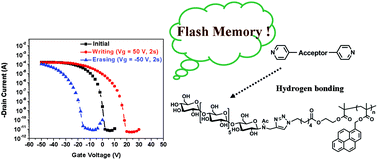Synthesis, morphology, and electrical memory application of oligosaccharide-based block copolymers with π-conjugated pyrene moieties and their supramolecules†
Abstract
We report the synthesis, morphology, and field effect transistor memory application of maltoheptaose-based block copolymers, maltoheptaose-block-poly(1-pyrenylmethyl methacrylate) (MH-b-PPyMA), and their supramolecules with (4-pyridyl)-acceptor-(4-pyridyl), MH(4Py-Acceptor-4Py)x-b-PPyMA. MH-b-PPyMA was prepared by the combination of the t-Bu-P4-catalyzed group transfer polymerization and the Cu(I)-catalyzed azide–alkyne cycloaddition reaction. After the thermal annealing process, the MH-b-PPyMA bulk sample underwent microphase separation to form the sub-10 nm periodic self-assembled nanostructure. The self-assembled morphologies transform from the hexagonal cylinder packing to the body-centered cubic sphere arrangement and the disordered spherical nanodomain with the increase of the PPyMA segment length. On the contrary, only the spherical nanodomain was observed in the thermo-annealed thin film samples of both MH-b-PPyMA and MH(4Py-Acceptor-4Py)x-b-PPyMA. The electrical characteristics of the p-type pentacene-based OFET memory device were studied using the thermo-annealed polymer thin film as the electret layer. The MH(4Py-Acceptor-4Py)x-b-PPyMA-based organic field effect transistor (OFET) devices had the high hole mobility of 0.20–1.08 cm2 V−1 s−1 and the ON/OFF current (ION/IOFF) ratio of 107–108, in which the acceptor of the benzo[c][1,2,5]thiadiazole (BT) based device possessed the higher hole mobility than that of the isoindigo-based one due to the more ordered packing pentacene crystals. The memory window (ΔVTH) of the supramolecule-based device was increased with enhancing the 4Py-Acceptor-4Py blending composition, and that of the MH(4Py-BT-4Py)1.5-b-PPyMA10-based device had the largest ΔVTH of ca. 9 V, a long-term retention time greater than 104 s and the high ION/IOFF memory ratio of 106–107 (reading at Vg = 0 V) for more than 100 programming/erasing cycles. Our results demonstrate that the bio-related block copolymers and their supramolecular thin film could be used as electret layers for high-performance nonvolatile flash green memory devices.


 Please wait while we load your content...
Please wait while we load your content...